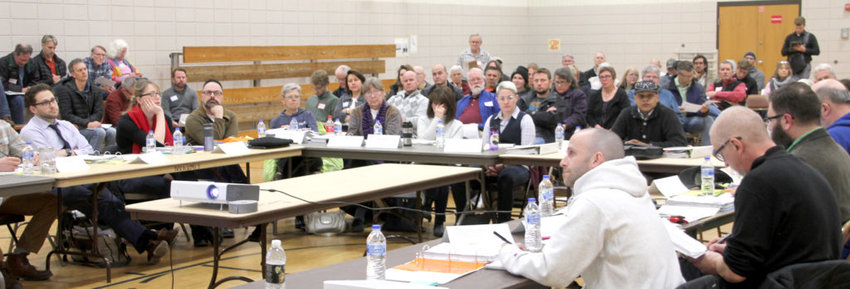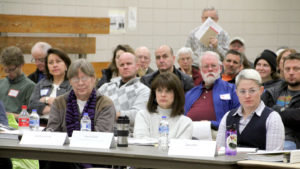 The charge for the Community Advisory Committee from the Minneapolis Park and Recreation Board (MPRB) is to make recommendations to the MPRB Commissioners in support of any changes to the golf course property or perpetuation of current uses, with attention to priority, sequencing, timing, and funding. About 100 community members attended the first CAC meeting on March 28 at the Nokomis Recreation Center. (Photo by Tesha M. Christensen)
The charge for the Community Advisory Committee from the Minneapolis Park and Recreation Board (MPRB) is to make recommendations to the MPRB Commissioners in support of any changes to the golf course property or perpetuation of current uses, with attention to priority, sequencing, timing, and funding. About 100 community members attended the first CAC meeting on March 28 at the Nokomis Recreation Center. (Photo by Tesha M. Christensen)
The future of Hiawatha Golf Course is being considered by 18 community members who have been appointed to a Community Advisory Committee (CAC).
Their charge from the Minneapolis Park and Recreation Board (MPRB) is to make recommendations to the MPRB Commissioners in support of any changes to the golf course property or perpetuation of current uses, with attention to priority, sequencing, timing, and funding.
“What should we do with this property with the reduced pumping scenario? Our job is to answer that question and come forth with recommendations to the park board,” said CAC Chair David Kaplan, who is also a board member of the Standish-Ericcson Neighborhood Association.
The CAC will work to understand past investigations, conducted by the MPRB and others, to gain a reasonable understanding of water management conditions on the golf course property and nearby private properties. They are also tasked with becoming knowledgeable about past and current use of the property, including communities served by the current golf course.
Members will act as primary contacts on the project within the community.
 Photo right: Community Advisory Committee Members (left to right) Kathryn Kelly, Joan Soholt and Tara Olds are among the 18 people who are studying what to do at the Hiawatha Golf Course. (Photo by Tesha M. Christensen)
Photo right: Community Advisory Committee Members (left to right) Kathryn Kelly, Joan Soholt and Tara Olds are among the 18 people who are studying what to do at the Hiawatha Golf Course. (Photo by Tesha M. Christensen)
CAC members are Anne Painter, Chakra Sankaraiah, Craig Nichols, Damon LeFlore, David Kaplan, Duane Whittaker, Joan Soholt, Kathryn Kelly, Matt Hilgart, Nathan Shepherd, Roxanne Stuhr, Sean Connaughty, Sean Keir, Sheila Terryll, Tara Olds, Teresa Engstrom, Tim Clemens, and William Means. Members represent groups such as a representative from the Anishinabe community, a golf coach, cross-country skiers, a Standish-Ericsson Neighborhood Association board member (who is serving as the CAC chair), a college professor, a landscape designer, a marine archeologist, member of the Friends of Lake Hiawatha, and more.
State Senator Patricia Torres Ray said that she is working with the Minnesota Department of Natural Resources to assign a staff person to the group.
The committee’s first meeting was held on Mar. 28, and was attended by about 100 community members. Upcoming meetings are set for Apr. 30 and May 30 from 6:30-8pm (locations to be determined).
Minutes and handouts from the first meeting, and other items included in the CAC member binders, are available on the MPRB project web site.
“We want to make this as transparent as possible because this is an issue that affects all of us,” pointed out Kaplan.
Minnehaha Creek Watershed District (MCWD) Board Member Brian Shekleton told those gathered that he has been attending meetings about the Hiawatha Golf Course since 2014, and he looks forward to being a resource.
“We have a partnership with the park board and the city of Minneapolis such that when any one of those entities does work along the water body, we all work together to think through the planning,” said Shekleton. “Our mission is to help people, entities, companies, and units of government to have better water quality when they do a project.”
CAC member Sean Connaughty, of Friends of Lake Hiawatha and the MPRB volunteer steward of Lake Hiawatha, discussed a grant he has received to work on mitigating the large stormwater sewer pipe that drains into the northwest part of Lake Hiawatha. He plans to share updates with the CAC as the project progresses.
“I think cleaning up the lake can be an exciting goal for all of us,” said Connaughty.
Disagreement regarding scope
Some CAC members, as well as community members, questioned the scope of the project and thought it was ‘putting the cart before the horse.’
“This has not been what some of us had been told,” observed CAC member Kathryn Kelly. “We’ve been told that everything is on the table, including an 18-hole golf course.”
MPRB Assistant Superintendent of Planning Services Michael Schroeder responded that he had discussed the issue with legal counsel, and was directed to follow the resolution in its entirety that was approved by the park board of commissioners last August and not pick certain pieces of it to use as the CAC charge. That resolution, he pointed out, begins by instructing the CAC to look at a reduced pumping scenario with the perpetuation of golf in some use.
“Any changes to our instruction need to come from the Board of Commissioners itself,” said Kaplan.
Treat each other as neighbors
With the help of MPRB Community Outreach, Equity & Inclusion Manager Radious Guess, ground rules for how the CAC will operate were agreed on.
These include: speak from your own experience, respect all voices, and listen to understand. Don’t just wait to speak, and don’t be afraid to ask questions. Speak with intention, no assumptions, ask for what you need to offer what you can, treat each other like neighbors, and seek common ground. The group should focus on compromise, with no screaming, think ecologically, and come with an attitude of collaboration, respect for science, and be transparent.
What the process looks like
After coming to an understanding of the project and getting to know the site and its various needs, the CAC will begin imagining possibilities—that is, thinking big for the future and developing guiding principles, according to MPRB Project Manager Tyler Pederson.
CAC members will then refine their big ideas, figure out how they fit into the larger Hiawatha-Nokomis Master Plan, and develop a focused vision before identifying a preferred direction.
The next step will be documentation–putting the plan on paper and developing recommendations to present to MPRB. Following that, the draft plan will be shared with a 45-day public comment period.
After it is approved by MPRB, the plan must also be adopted by the Met Council.
It may require alignment with permitting agencies: US Army Corps of Engineers, US Fish and Wildlife Service, Minnesota Department of Natural Resources, Minnesota Board of Water and Soil Resources, Minnesota Pollution Control Agency, State Historic Preservation Office, Minnesota Office of State Archaeologist, city of Minneapolis, and the Minnehaha Creek Watershed District.
Information from the two other advisory groups, the Technical Advisory Panel and the Project Advisory Committee, will be shared during the process.
“We’re at the very beginning of this process, even though we’ve been here for many years,” pointed out Pedersen.
Work will be fluid
Next up will be forming a consultant team. MPRB has already received three proposals from companies that have a variety of staff members in areas such as engineering, landscape architecture, recreation specialists, golf course architecture, ecological engineering and more. Interviews will be ranked by MPRB staff members, and a recommendation of one proposing consultant will be sent to the board of commissioners for contract approval.
MPRB is also seeking a cultural advisor from the Dakota community.
While some questioned how the group could plan without knowing all the answers related to the water issues, Schroeder acknowledged that they would make course adjustments as they go.
“Your work here will have to be somewhat fluid,” he stated. “As we learn information from other sources, we’ll bring it back to this group.”
Those with comments are encouraged to email tpederson@minneapolisparks.org or fill out an online comment form at https://www.surveymonkey.com/r/lake-hiawatha.
Comments
No comments on this item Please log in to comment by clicking here